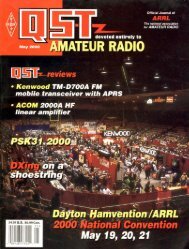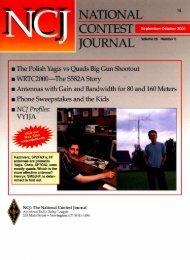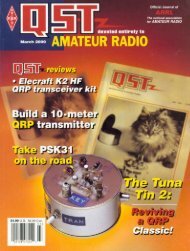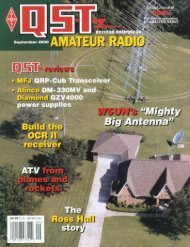Create successful ePaper yourself
Turn your PDF publications into a flip-book with our unique Google optimized e-Paper software.
WORKBENCH<br />
PROJECTS AND INFORMATION FOR THE ACTIVE AMATEUR<br />
The Doctor is IN<br />
QDave, WD8DK, asks, “I am using a G5RV on 80-6 meters.<br />
How efficient is this antenna on 6 meters I have been<br />
told that it is very inefficient on this band. In fact, I have been<br />
told that a 1 /2 wavelength dipole is more efficient than the<br />
G5RV on 6 meters. Any comments”<br />
AOn 20 meters, where the G5RV was designed to operate, it<br />
boasts a little gain over a conventional half-wave dipole.<br />
Given a reasonably efficient feed line (450-Ω line) and a good<br />
antenna tuner, there’s no reason why the G5RV can’t be at least<br />
as “efficient” as, say, a coax-fed dipole in the HF bands.<br />
However, on 6 meters the G5RV acts as a long-wire antenna,<br />
with an azimuthal pattern with multiple, very narrow lobes. The<br />
narrow lobes are what give it gain, but also what make its<br />
performance compared with a regular garden-variety dipole<br />
inferior in direc-tions other than the ones it favors. The EZNEC<br />
plot shown in Figure 1 assumes that the antenna is mounted as a<br />
flat top at 50 feet above average ground. The G5RV has<br />
significantly more gain than the simple dipole, but it achieves this<br />
mainly in four, narrow-beamwidth directions. For the rest of the<br />
azimuths, its pattern has nulls that the dipole covers well.<br />
Any multiband antenna is a compromise, but most of us can’t<br />
have five or more dipoles hanging in our backyards. On 6 meters<br />
I would recommend a separate antenna designed for that band.<br />
There are a couple of inexpensive 6-meter wire antenna designs<br />
on the ARRL TIS Web site at http://www.arrl.org/tis/. Go there<br />
and click on “Antenna Projects,” and then “Other VHF Antennas.”<br />
QI have a 10-year-old Realistic 13-inch color TV that I use<br />
with my ATV station. Recently the TV went completely<br />
dead. It won’t turn on when I press the ON button on the front<br />
panel, or when I try to turn it on from the remote. I checked the<br />
power supply fuse and it is okay. The power supply appears to<br />
be working as well. Any ideas<br />
TVs operate in what you might call a “sleep” mode.<br />
AMany That is, there are circuits within the TV that are active<br />
continuously—even when the rest of the TV is off. Usually the<br />
primary microprocessor is always active, waiting for the<br />
command to switch on the rest of the set. If the microprocessor<br />
isn’t responding to manual or remote “on” commands, the<br />
microprocessor could be defective. If you have a volt-ohm meter<br />
and a schematic diagram, measure the voltage at the V cc<br />
pin of the<br />
microprocessor. Is it receiving power from the power supply<br />
(probably 5 V) If so, find the microprocessor pin that produces<br />
the output signal to turn on the rest of the TV. Do you get a<br />
reading at this pin when you press the TV’s “ON” button If not<br />
(and I suspect you won’t), the microprocessor is probably dead.<br />
On the other hand, if you do get a reading, it’s time to troubleshoot<br />
the rest of the circuit that is responsible for switching on the set.<br />
This is likely to include a couple of switching transistors and<br />
possibly an optoisolator.<br />
QLast night I heard a strange CW signal on 6 meters. It was<br />
hissing and buzzing, but I was still able to copy. To my<br />
astonishment, I learned that the station was 500 miles away<br />
from me. Was this sporadic E propagation<br />
AMy guess is that you heard auroral propagation. The clue is<br />
your description of the signal as having a hissing or buzzing<br />
characteristic.<br />
Those of us who reside at the higher latitudes are occasionally<br />
treated to the visual spectacle of the aurora borealis, better known<br />
as the “northern lights.” (Yes, there are “southern lights” as well,<br />
visible occasionally in South America and Africa.) The aurora is<br />
caused when the Earth intercepts a stream of charged particles<br />
Figure 1—This is an EZNEC plot of a G5RV antenna on 6<br />
meters compared to a dipole cut for 6 meters. The solid line<br />
represents the G5RV pattern while the dashed line represents<br />
the dipole. Notice that the G5RV is creating numerous narrow<br />
lobes of radiation.<br />
48 <strong>November</strong> <strong>2000</strong><br />
Figure 2—The auroral “curtain” can function like a giant<br />
mirror in the sky, reflecting radio signals over substantial<br />
distances.

















